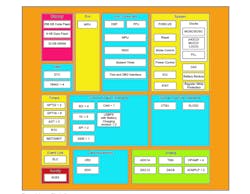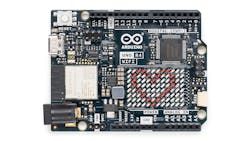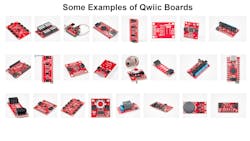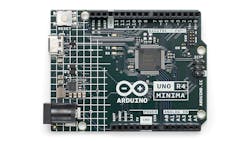Beginner-Friendly Boards Equipped with 5-V, 32-Bit MCUs
Check out more TechXchange Talks videos.
What you’ll learn:
- What is the difference between the Arduino UNO R4 Minima and Wi-Fi versions?
- Why 5-V support is important.
- What is Qwiic and why is it supported?
The new Arduino UNO R4 series includes the UNO R4 Minima and UNO R4 Wi-Fi. The latter includes Wi-Fi and Bluetooth support using an Espressif Systems ESP32-S3 module, providing a two-core environment. I talked with Massimo Banzi, Co-founder, Chairman, and CMO at Arduino, about the UNO R4 and about the company and its platforms (watch the video above).
The UNO R4 family is based on a 48-MHz Renesas RA4M1 5-V microcontroller that contains an Arm Cortex-M4 core (Fig. 1). The key is the 5-V support shared with many of its predecessors, including the UNO R3. The original Arduino was built around a 5-V, 8-bit ATMega microcontroller. Arduino, the company, has delivered a range of boards with the standard Arduino header but only some have had 5-V support.
Most microcontrollers and microprocessors have moved to lower voltages, like 3.3 V, to reduce power requirements. Luckily, the Renesas chip can handle the higher voltage allowing it to work with existing Arduino "shields” that can stack on top of the board.
The power-supply support has also been improved so that it can handle both higher USB-C voltages and direct power-supply inputs up to 24 V. Thus, a system can be built with other devices like motors where a higher voltage is useful.
The MCU includes a 12-bit digital-to-analog converter (DAC) and a 25-channel, 14-bit analog-to-digital converter (ADC). Four operational amplifiers can be used. There's the typical complement of serial ports, including SPI and I2C, along with a CAN interface. It implements 256 kB of flash and 32 kB of SRAM provide a substantial workspace for applications. And 8 kB of EEPROM is available for non-volatile data.
The RA4M1 includes a 27-channel capacitive-touch sensing unit.
Other Common Features
Debugging support has been improved in both the software that comes with the Arduino IDE 2.0 and the hardware, which now has a software-debug (SWD) connector. This provides more conventional embedded debugging support as well as a significantly better development environment than using print statements to a terminal interface.
Thanks to the USB support, the system can emulate a standard USB Human Interface Device (HID), allowing it to act as a keyboard or mouse. This is one way to get data back to a host computer.
The larger memory is always a plus—there's sufficient space for an operating system and applications. Offloading the wireless support to the ESP32 on the Wi-Fi version means the Cortex-M4 can use its capabilities for the application instead of wireless communication.
Introducing the Arduino UNO R4 Wi-Fi
The Arduino UNO R4 Wi-Fi is the high-end platform (Fig. 2). Wireless support from ESP32 module allows the system to handle 802.11/g/n (Wi-Fi 4) with a bit rate up to 150 Mb/s. It only works in the 2.4-GHz band. Bluetooth 5 LE is included as well. The module runs a 32-bit, dual-core Xtensa LX7 microprocessor running at 40 MHz. It also has its own built-in antenna and software stack.
The UNO R4 Wi-Fi includes a Qwiic header, which facilitates integration with Qwiic modules (Fig. 3). The de facto standard was started by Sparkfun Electronics, which sells a range of Qwiic modules.
Qwiic modules have a standard connector for a four-wire cable that includes power and ground plus two I2C signals. This supports star and daisy-chain configurations and is designed to handle low-bandwidth sensors and control systems. It's much easier and usually more cost-effective to use a Qwiic-based sensor that may be a single chip rather than an Arduino shield with the chip on it. Qwiic also runs at 3.3 V. The UNO R4 Wi-Fi handles the voltage translation.
The UNO R4 Wi-Fi includes a 12x8 LED matrix. It's connected to the microcontroller using a method known as charlieplexing. Charlieplexing employs a tristate multiplexing scheme to reduce the pin count for the matrix to 11 pins versus 20 for a more conventional layout. It does require the system to cycle the outputs to generate the display.
Introducing the Arduino UNO R4 Minima
The Arduino UNO R4 Minima includes the processor chip and not much more (Fig. 4). It foregoes the wireless support but still exposes the chip’s features like the CAN interface. It retains the USB interface and incorporates I2C, but the Qwiic connector isn't included. It's possible to include an Arduino shield to provide such support.
Closing Thoughts
The Arduino UNO R4 family represents a major upgrade while maintaining backward compatibility.
Links




